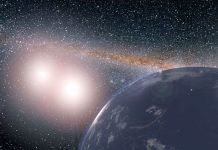
In the vast expanse of our galaxy lies a peculiar phenomenon: white dwarfs, eerie remnants of stars long gone.
Imagine these as dense, Earth-sized objects with the mass of our familiar sun. They’re not rare; in fact, they make up a whopping 97% of stars in our galaxy.
But despite their abundance, these cosmic relics have baffled astronomers for years, hiding a secret in their metallic surfaces.
Here’s the puzzle: white dwarfs often sport heavy metal elements like silicon, magnesium, and calcium on their surfaces.
But according to our stellar knowledge, these metals should sink into the core of the white dwarf in no time. So, how come they’re still hanging out on the surface?
A team of clever scientists, led by JILA graduate student Tatsuya Akiba, may have cracked the cosmic code.
They tinkered with computer simulations to understand why these stellar zombies seem to have a taste for nearby cosmic snacks, like comets and asteroids.
Imagine a white dwarf getting a cosmic push during its formation, kind of like a space boot to its celestial rear. This kick messes with its motion and the stuff around it, sending nearby objects on wild orbits.
In their virtual universe, the researchers found that these kicks elongate the orbits of space rocks within a certain range of the white dwarf. And get this—some of these rocks start orbiting in reverse! It’s like cosmic chaos ballet.
What’s more, even after a mind-boggling 100 million years, these space rocks still dance around the white dwarf, forming a sort of cosmic buffet.
But why does this matter beyond being an intriguing celestial dance? Well, understanding how white dwarfs chomp down on cosmic snacks tells us a lot about how solar systems like ours change over eons. Picture this: most planets in the universe will end up orbiting a white dwarf eventually.
That means our solar system might one day be on the menu! These findings are like peering into a crystal ball, giving us a glimpse of our cosmic future.
And there’s more to it. By studying these cosmic leftovers, we learn not just about the past but also about the future of other solar systems out there.
It’s like looking through a window into a galaxy of possibilities, where white dwarfs aren’t just ancient graves but cosmic storytellers, whispering tales of celestial feasts and the dance of the cosmos.



